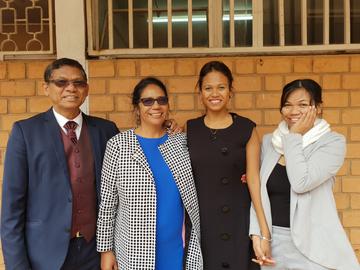Towards a forecast model for lychee harvesting in Madagascar
Since 2016, Aina has conducted her research at the Horticultural Technical Center of Tamatave (CTHT) under the supervision of Fanja Fawbush (UA) and Michel Jahiel (CIRAD), and under the direction of Jean Rasoarahona (UA) and Eric Malézieux (CIRAD).
During her thesis, Aina was welcomed several times in the HortSys unit at Cirad in Reunion to participate in training sessions or support missions with Frédéric Normand and Thierry Michels. Her visits to Reunion and France were financed thanks to the Interreg-V Qualinnov project, the French Government Scholarship and Cirad Incentive Actions.
Abstract
Madagascar is the world biggest exporter of lychee to Europe. This position is due to the country’s particular characteristics of production that allows an early production and harvest in comparison to major Asian producers like China and neighboring countries like South Africa. Madagascar is the only country able to supply the European market with 20 000 tons of medium-sized 30 mm lychees during the end of the year holidays. The collection area is essentially on the east coast in the Tamatave area. Nevertheless, little knowledge has been established about the locations of this production and the parameters involved in maintaining it from production irregularity issue.
The purpose of this dissertation is to determine the parameters at different scales that can be used to evaluate and predict the production.
First, a characterization of lychee-based cropping systems was carried out in 2016 and 2017. It revealed three types of cropping systems: monoculture, parkland and agroforestry system or agroforest. The cropping systems were mainly characterized by the structure variables of the plot. The setting up and dynamics of these systems related to the socio-economic context of Madagascar. Malagasy lychee comes from various cropping systems that could be the origin of production variability. Concerning the quantitative characteristic, simple tools have been developed to estimate the fruit production of a tree during the 2015 and 2016 campaign. This is the first variable used for the quantitative estimation at larger scales: at the level of the plot and the production basin. Several tree measurements (i.e, diameter of basal trunk, diameter breast height or DBH, canopy size, number of bunches, fruit load) were implemented to estimate the number of fruits and their total weight. Simultaneously, image analysis was also performed to estimate the tree production. The results showed a large variation of production between the trees, ranging from 1 to 860 kg. Concerning the qualitative characteristics, a comparison of the performances of the cropping systems was carried out in 2016 and 2017. The results showed that the cropping system and site location (lowland vs tanety) influenced the fruit maturity, its size and the taste quality. These influences would be related to the particular characteristics of the systems that are related to the water access, the sun exposure and the soil properties.
Apart from reconciling the quantitative and the qualitative parameters, estimating the optimal starting date of harvest is an essential element for the lychee industry. Establishing early on the optimal date of harvest allows to estimate more accurately the quantity of mature and good size lychee fruits that can be handled within the limited time allocated to fill the boats so that the exported fruits reach its destination prior to the end of the year festivities. A monitoring system that reconciles geographic variabilities (on tree, plot and region scales) and temporal variabilities (year from 2012 to 2017) has led to the development of an optimal harvest date forecasting model. Observations from the flowering stage make it possible to estimate the precocity of the harvest. Then a logistic model based on the evolution of fruit growth allows to precise the optimal date of harvest corresponding to the date of opening of the lychee campaign. The localization of the lychee plots by photo interpretation in 2016 and 2017 allowed to estimate the production potential on the collection area at 45,000 tons. A spatial analysis of the plot distribution in 2017 and 2018 revealed a proximity of the majority of plots close to the product evacuation ways (roads, rivers). It showed a predominance of monocultures in the South (Brickaville) where fruits currently ripe earlier, and an importance of agro-forests in the North (Fenerive Est) where fruits ripe later.

